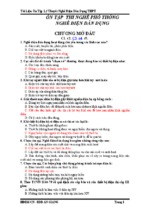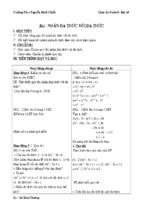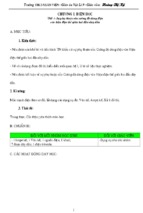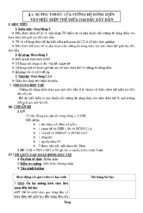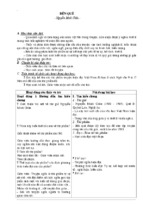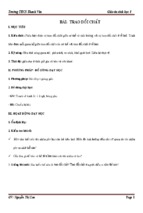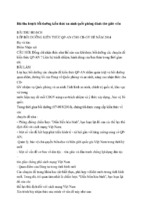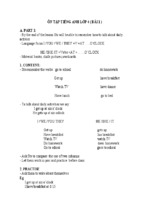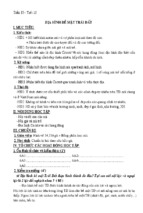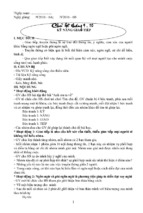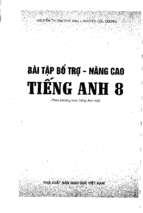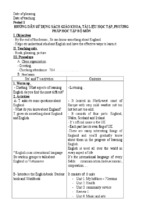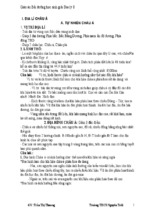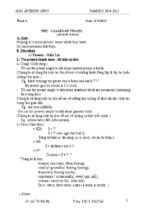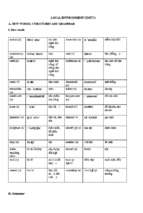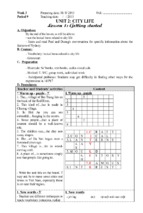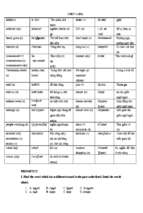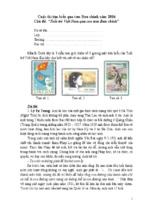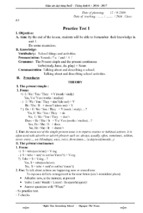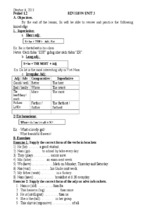Trêng THCS Th¸i Thuû
Period 1
«n tËp kiÕn thøc träng t©m líp 8
Prepare : 24/8 /2008
Teaching: 25 /8 /2008
I. Aims of the lesson:
Gióp häc sinh hÖ thèng l¹i mét c¸ch c¬ b¶n c¸c kiÕn thøc mµ c¸c em ®· ®îc
häc ë líp 8 tõ ®ã cã c¬ së ®Ó tiÕp thu mét c¸ch cã hiÖu qu¶ kiÕn thøc líp 9.
II. Teaching aids:
HÖ thèng kiÕn thøc líp 8.
III . Teaching steps:
1-¤n vÒ lý thuyÕt.
Th× qu¸ khø ®¬n
Form:
S + v(ed)/v(cét 2)+….
S + did not +V(inf)+….
Did + s + V(inf)+….
Uses:
Th× qu¸ khø ®¬n ®îc dïng ®Ó diÔn t¶ 1 hµnh ®éng ®· x¶y ra vµ chÊm døt t¹i mét thêi ®iÓm x¸c
®Þnh trong qu¸ khø.
DÊu hiÖu nhËn biÕt:
Yesterday, last (night, month,year,……)
(Two days, one year, five months……..)ago….
Examples:
-I watched TV last night.
-Th× hiÖn t¹i hoµn thµnh:
Form:
-My mother did not go to Treo market yesterday.
S + HAVE/HAS +PP(VED/VCéT 3)
Use:
Th× hiÖn t¹i hoµn thµnh ®îc sö dông ®Ó diÔn t¶ mét hµnh ®éng x¶y ra t¹i mét thêi ®iÓm
kh«ng x¸c ®Þnh trong qu¸ khø, mét hµnh ®éng b¾t ®Çu trong qu¸ khø kÐo dµi ®Õn hiÖn t¹i vµ cã thÓ
tiÕp tôc ®Õn t¬ng lai…
Examples:
I have met my old teacher.
She has lived in Thai Thuy for 20 years.
DÊu hiÖu nhËn biÕt:
Ever, never,already,just,recently,yet,……………..
Since+ mét mèc thêi gian(2000/last month/…..)
For + mét kho¶ng thêi gian( 2 years/ 9 hours….)
2-PhÇn thùc hµnh:
I- khoanh trßn ®¸p ¸n mµ em chän
1. Have you ______ any news about Lan since her bike accident?
B. hearing
C. to hear
D. heard
2. We ______ dinner when my friends arrived yesterday evening.
A. are having
B. is having
C. were having
D. was having
3. The glass bottle will be broken ______ small pieces.
A. into
B. to
C. in
D. by
4. They don’t want ______ to the market now.
A. hear
Mai V¨n L¹ng
Gi¸o ¸n TiÕng Anh 9
A. go
B. to go
C. going
D. went
5. I ______ home for school at 7 o’clock every morning.
A. start
B. leave
C. go
D. move
6. The girl enjoys ______ her fitness exercise after classes.
A. doing
B. to do
C. do
D. did
7. I have known her _______ two years.
A. for
B. since
C. with
D. within
8. I’d like you ______ with me for some days.
A. staying
B. to stay
C. stayed
D. will stay
9. Used paper is collected and _______ to factories.
A. sent
B. sending
C. send
D. to send
10. I am happy _______ all the exams.
A. passed
B. pass
C. passing
D. to pass
1. Phong Nha Cave is in the _________ of Viet Nam.
A. southern
B. northern
C. south
D. north
2. She asked me __________ I liked coffee.
A. as
B. if
C. or
D. and
3. Millions of Christmas cards ______every year.
A. were sent
B. are sent
C. send
D. will send
4. Taj Mahal is _______ famous of all India’s ancient buildings.
A. more
B. most
C. the most
D. best
5. My mother is very keen ________ growing roses.
A. on
B. in
C. of
D. about
6. A test in which participants have to fetch water is called _______.
A. water-fetch contest B. fetching-water contestC. water-fetching contest. D. fetch-watering
contest
7. He said that he would come there _______.
A. tomorrow
B. the following
C. the following day D. next day
8. Do you mind ________out your cigarette - No, of course not.
A. put
B. putting
C. to put
D. is putting
9. A workman who repairs water-pipes is called ______.
A. plumber
B. worker
C. farmer
D. repairer
10. Finally, we decided __________to the cinema.
A. going
B. go
C. to go
D. gone
N¨m häc: 2008-2009
Trêng THCS Th¸i Thuû
Period 2
Unit 1: A visit from a pen pal
Lesson 1: Getting started + Listen and Read
Prepare : 26/8 /2008
Teaching: 27 /8 /2008(9c)
30 /8 /2008(9a)
I. Aims of the lesson:
By the end of the lesson, sis will be able to know about some places LAN went
to with a foreign friend and some activities they took part in together
Practice with the structures: : S + wish +S + Past simple
Be - were
II. Teaching aids:
Textbook, board, pictures, tape, recoder.
III. Training skills:
Listening, spreaking, reading, writting.
IV. Teaching steps:
Teacher’s tasks
Students’ tasks
Display on the board
1. Warm up:
*Chatting:
Answer teacher's questions
Asks some questions
individually.
?Do you have any pen pals?
Yes/ No, I have (not)
?Where does s/he live?
?Have s/ he ever visited your city? S/He lives ....
Yes/ No. I have (not)
What activities would you do
during the visit?
2 . Presentation
*Present vocabulary
- Gives vocal and teaches them
-to correspond: (explanation): trao
®æi thu tõ
-a mosque: (picture): nhµ thê håi
gi¸o
-to be impressed: (explanation):
cã Ên tuîng
-to pray: ( mine): cÇu nguyÖn
- Guides to check R. O. R
* Gap fill:
-Asks Ss to read the text again to
choose the correct option to
complete the sentences on page
? Work in pairs
1. Lan and Maryam usually write
to one another every two weeks
2. Maryam was impressed
because Hanoi people were
friendly
3. The girls went to see famous
places in Hanoi
4. Maryam wanted to invite Lan
to Kuala Lumpur.
*Model sentence:
Asks ss to translations sentence
“T«i ¬c g× b¹n cã kú nghÜ dµi
h¬n”
? Give form
? How do you use it?
Listen to the text to find
some new words
Listen and guess the words
from T's eliciting
Repeat in chorus
individually
Copy the new words
Check by play the game:
R.O.R
1-New words:
- to correspond: (v) trao ®æi th
tõ
- a mosque: (n) nhµ thê håi gi¸o
- to be impressed: (v) cã Ên tîng
- to pray: (v) cÇu nguyÖn
2. Reading:
*Gap fill:
1. Lan and Maryam usually
Read the text again to
choose the correct option to write to one another every two
weeks
complete the sentences in
2. Maryam was impressed
pairs.
because Hanoi people were
Key
friendly
C. two weeks
3. The girls went to see famous
B. Hanoi people were
places in Hanoi
friendly
4. Maryam wanted to invite
A. famous places in HN
Lan to Kuala Lumpur
B. invite Lan to Kuada
* Modal sentences:
Lampur
I wish you had a longer
I wish you had a longer
vacation
vacation
Form:
S + wish + S + Past simple
Be - were
Use: C©u mong uíc: mong uíc
ë hiÖn t¹i vµ khã thùc hiÖn ®îc
ë hiÖn t¹i
Mai V¨n L¹ng
Gi¸o ¸n TiÕng Anh 9
3. Practice:
* Work cue drill:
? Practice by steps
a. He /wish/ he/ be Hue now
b. Lan/ wish/ she speak English
quickly
c. Nga/ wish/ she/ have/ a lot of
money
d. Lai / wish/ she/ go to beach
4. Further practice:
*Discussion
-Asks Ss to recommend places of
interest in their city.
-Asks them to discuss where they
should take their friends to and
what activities they should go
Cues:
+ Lang Co Beachswimming/beach in Hue
+ Bach Ma national park mountain climbing ecological
tour
+ Linh Mu pagoda. Tu Duc Tombsightseeing beautiful sight.
Gives feed back by calling leader
to report in frond of the class
5. Consolidation
New word, text.
6. Homework
Write the short paragraph about
what they have just discussed
with your friend
Key:
a. He wishes he were in
Hue
b. Lan wishes she spoke
English quickly
c. Nga wishes she had a lot
of money
d. Lai wishes she went to
beach
Answer: places of interest
in their city.
Discussion in groups of 5
students
Write the short paragraph
about what you have just
discussed with your friends
* Word cue drill:
a. He /wish/ he/ be Hue now
b. Lan/ wish/ she speak English
quickly
c. Nga/ wish/ she/ have/ a lot of
money
d. Lai / wish/ she/ go to beach
*Discussion
+ Lang Co Beachswimming/beach in Hue
+ Bach Ma national park mountain climbing ecological
tour
+ Linh Mu pagoda. Tu Duc
Tomb - sightseeing beautiful
sight
3. Home work
Ex: 5(8)-7(10)
Period 3
Unit 1 : A visit from a pen pal
Lesson 2: Speak and Listen
Prepare : 02/9 /2008
Teaching: 03(06) /9 /2008
I. Aims of the lesson :
By the end of the lesson, Ss will be able to make and respond to introdution.
Listen to specific information to select the correct pictures
II. Teaching aids:
Textbook, board, pictures, tape, recoder.
III. Training skills:
Listening, spreaking, reading, writting.
IV. Teaching steps:
Teacher’s tasks
1.Warm up:
* Melanism
Divides ss into two teams and asks
them to choose two numbers.
Students’ tasks
Do the tasks in to two groups
Display on the board
* Melanism
Tokyo
Australia
Liverpool
Vietnam
N¨m häc: 2008-2009
Hoi an
Perth
Bombay
England
Japan
India
Trêng THCS Th¸i Thuû
2. Pre - Teach
1. Speaking
* Ordering
Listen to the teacher
*Ordering
Introduces the situation: Nga is
talking to Maryam. They are
answerkeys
waiting for Lan outside her school.
1.c.
Put the dialogue in the correct 5.b.
? Put their dialogue in the correct
orders and copy it in to their
orders and copy it into your
4.d
notebooks.
exercises book.
2.e
- Answer the questions
Asks some questions to check
3.a
* No
Ss’understanding.
? Have Nga and Maryam met each * Yes
- VN people are very friendly
other before?
and HN is a very interesting
? Is Maryam enjoying her stay in
city.
HN?
? What does she like in VN.
Feed back
*Role play
3. While - speaking
Practice with their partners.
* Role play
? one is Lan's friend and one is
Maryam 's friend to practice
2. Listening
Feed back
*Open prediction:
2. Pre listening:
*Open prediction:
Sets the scene: "Tim John' s
Mexican pen pal, Carlos is visiting
the USA"
*They are going to park...
? Look at the pictures to guess the *They are....
answering.
*They an get there....
? Where are they going to go?
? What are they doing to do?
? How do they get there?
*Question given:
? Where are they eating?
1. Are the trees and flowers
Listen to the dialogue and
3. While - listening
beautiful?
check
their
predition
Asks ss to listen to the dialogue
Look at the pictures and choose 2. What can they do on
one time to check their predition
Ocean Drive?
correct pictures
Feed back - evaluation
3.What are they walking
- Listen to the dialogue to
? Listen again and answer the
on?
answer
the
questions
questions
individually
4. Post speaking
Make dialogue 3 and copy
* Role play
them into notebooks.
Sets the scene: You are talking to
Maryam’s friends . Introduce
Listen
yourself. Make some similar
dialogues take turns to be one of
Maryam’s friends.
? Work in Pairs
5. Consolidation.
2. Home work
New words, dialogue.
Do ex:3,4
6. Home work:
- Asks Ss to make dialogue 3 and
copy them into notebook.
Ex:3,4
(1)A. Hello you must be Yoko
B. That night, I am
A. Are you enjoying your stay in Hue?
B. Oh , yes, very much. I like Vietnamese people and I love old cities in VN.
A. Do you live in the city, too?
B. It’s big capital city. It’s very different from Hue
A.I see
(2)A. Hello, you must be Paul.
B. What’s night . I am.
A. Pleased to meet you. Let me introduce myself I’m Le.
B. Are you enjoying your stay in Vietnamese .
A. Do you live in a city, too?
B. You. I live in Liverpool in England have you been there?
Mai V¨n L¹ng
Gi¸o ¸n TiÕng Anh 9
N¨m häc: 2008-2009
Trêng THCS Th¸i Thuû
Unit 1:
Period 4
A visit from a pen pal
Lesson 3: Reading
Prepare : 08/ 9 /2008
Teaching: 09/ 9 /2008
I. Aims of the lesson :
By the end of the lesson ss will have some knowledge about Malaysia, one of
the countries of ASEAN.
II. Teaching aids:
Textbook, board, pictures, tape, recoder.
III. Training skills:
Listening, spreaking, reading, writting.
IV. Teaching steps:
Teacher’s tasks
Students’ tasks
I. Warm up:
Hangman
Do the tasks
Draws strokes on the board.
Each stroke stand for a letter of Play the game
the word student’s take turn to
guess the letters of the word.
The word has - - - - - - Letters. It’s Malaysia
II. New lesson
1. Pre - reading:
*New words
- Comprise (explanation):bao
gåm
- Currency: (example) tiÒn tÖ
- Tamil: (example) TiÕng Latin
- Compulsory: (Explanation)
b¾t buéc
Checks R.O.R
* Pre questions
Gives some questions and asks
ss to guess answering
? Where is it?
? What is the capital of
Malaysia
? What is its population?
? How big is Malaysia?
? What language is spoken in
this country?
? Work in 2 groups
2. While - reading:
- Asks ss to read the text to
find out the answers to their
questions.
- Gives feedback to the class.
- Asks ss to read the text the
second time to fill in the chart
in exercises (a) on page 10.
Listen and guess the
words from T's eliciting
Repeat in chorus and
individually
Board
1. New words:
- to Comprise :(v) bao gåm
- Currency: (n)tiÒn tÖ
- Tamil: (n) TiÕng La tinh
- Compulsory: (a) b¾t buéc
Check by play the game:
R.O.R
Work in 2 groups
Guess and answer then
write on the board
Read the text to find out
the answers to their
questions.
Read the text the second
time to fill in the chart in
exercises (a) on page 10.
2. Reading
*Answer given
Mai V¨n L¹ng
Gi¸o ¸n TiÕng Anh 9
- Read the text to do T/F
* True / False statements.
? Read the text to do the “True
or False statements” P 10 . If it
is T or F Why is it? How can
you correct?
? Work in pairs then work in 2
groups to write on the board.
Feed back
3. Post - reading:
* Interview:
-Asks Ss to work in pair
-Gives Ss their task.
A: You are going to visit
Malaysia.
Prepare some questions to ask
Maryam about her country
(use the chart to ask)
B. You are Maryam from
Malaysia. You have to answer
A’s questions about your
country.
III. Consolidation.
Some information about
Malaysia, one of the countries
of ASEAN.
IV. Home work
? Write some information
about your country
Ex: 2(6)
- Work in pairs then
work in 2 groups to write
on the board.
- Answer individually
- Work in pairs
He interviews : may start
like this
A. Hi, Maryam. I am
going to visit Malaysia
next summer holiday, I'd
like to know some
information about your
country, can you help
me?
B. Yes, certainly
...................
Write some information
about your country to
make ask and answer the
question.
Ex: 2(6)
*True/False statements.
1.T
2.F(there are more than two
religions)
3.F( English,Chinese,and Tamil are
also widely spoken)
4.F( One of the three: Malay,
Chinese,Tamil)
5. F(English is a compulsory second
language, not primary language)
*Interview:
A: Visitor: Hi, Maryam. I am going
to visit Malaysia next summer
holiday, I'd like to know some
information about your country, can
you help me?
B: Maryam: Yes, certainly
A:……..
B:…….
A:…….
B:……..
Home work
? Write some information about
your country
Ex: 2(6)
Period 5
Unit 1 : A visit from a pen pal
Lesson 4: Write
Prepare : 12/ 9 /2008
Teaching: 13/ 9 /2008
I. Aims of the lesson :
Write a peosonal letter.
By the end of the lesson, Ss will be able to write a personal letter.
II. Teaching aids:
Textbook, board.
III. Teaching steps:
N¨m häc: 2008-2009
Teachers’ tasks
I. Warm up
* Chatting
? Have you ever visited any
famous places in Vietnam?
? When did you go?
? How did you get there?
? Did you visit any places of
interest?
? Did you buy any thing?
? When you are away from home
do you keep in touch ? How ?
II. New lesson
1. Pre- writing
* Answer given
Sets the sence: “Imagine you are
visiting your relatives or friends
in another part of Vietnam or
different country”.
? Answer the following questions.
? Where are you now?
? How did you get there?
? Who did you meet?
? What have you done?
? What places have you visited?
- Who have you met?
- What kinds of food have you
tried?
- What souvenirs have you
bought?
? How do you fell now
? What do you think interest you
bought.
? When will you return home.
? Work in pairs to talk to each
other about their visit.
- Reminds Ss about the format of
a personal letter by asking the
question: What are the parts of a
personal letter .
2. While- writing:
*Write it up
? write a letter to their family,
telling them about their visit.
? look at the outline on page 11
? What parts of the letter are they
going to write (body of the letter).
? follow the outline to write their
own letter.
- Asks them to swap their letters
compare with their partners
correct if they can.
3. Post- writing:
* Correction
Chooses some letters to correct
III. Consolidation
To write a personal letter.
Students’ tasks
Trêng THCS Th¸i Thuû
Board
Answer T’squestions
individually
- Listen
- Answer the questions
+ I am.......
+ I got there by bus/ car..
+ I met my.......
+ I have.............
+ I visited some places...
+ I have met ....
+ I have tried.......
+ I bought .........for........
+I fell happy......
+I think..........
+ I am.......
+ I got there by bus/ car..
+ I met my.......
+ I have.............
+ I visited some places...
+ I have met ....
+ I have tried.......
+ I bought .........for........
+I fell happy......
+I think..........
1. Format of a personal letter
A. Heading
Work in pairs to talk to B. Opening
each other about their visit. C. Body of the letter
Answer the question
D. Closing
A. Heading
B. Opening
C. Body of the letter
D. Closing
2. Writing
* Answer given
Write a letter to their -Write it up
family.
First paragraph:
Say when you arrived and who
Look at the outline to met you at the bus/train
answer
station/airport.
Swap their letters compare Second part:
with their partners
- Talk about
Look and correct
-What you’ve done
-Places you’ve visited
- people you’ve met
- food you’ve fried
write a letter after
- things you’ve bought
Third Para.....
- tell how you feel
(happy/disappointed…..)
-Say what interests you most...
- Mention when you return
correction.
home.
* Correction
Mai V¨n L¹ng
Gi¸o ¸n TiÕng Anh 9
IV. Home work.
? write a letter after correction
? write a letter after
correction
4. Home work.
Suggested ideals:
I arrived at Da Nang airport/train station/bus
station at 2 pm/8 am/late in the afternoon/at midnight,
on Tuesday/Wednesday….
Hoa/Nam/Uncle Tan/Aunt Huong met me at the
airport…………
I’ve visited/been to many places like the
beaches,the Cham Museum, Marble Mountaints,
supermarkets…….
I’ve tried different foods : sea food, Da Nang
specialties………
I’ll visite Hoi An and My Son tomorrow/ on Sunday…
I feel so happy and enjoy myself so much, The
people here are so nice and friendly, the food are so
delicious,and the sights are so beautiful.
I’ll leave Da Nang at 2pm/7pm… next Thursday/
Period
Sunday….and will arrive
home 6
at 11 pm/ 5am….. Please
Unit 1 : A visit from a pen pal
pick me up at the airport/ bus station/…..
Lesson 5: Language focus
I. Aims of the lesson :
Use past simple and past simple with"wish’
II. Teaching aids:
Textbook, board.
III. Teaching steps:
Teacher’s tasks
I. Warm up:
*Pelmanism
Devides the class in to 2 teams and
asks them to choose two numbers
which content the verb in INF and
in its Past form
Feed back
II. New lesson
1. Presentation:
-Sets the scene: This is the
conversation between Tan and
Phong. They are talking about what
Ba did on the weekend.
- Gives the beginning dialogue as
examples.
Asks ss to give form of the past
simple
N¨m häc: 2008-2009
Students’ tasks
Do the tasks
Play the game in 2 groups
- Prepare : 15 / 9 /2008
- Teaching: 16 /9 /2008
Display on board
1. see 2. go
3.watch 4. buy
5.draw 6. saw
7.drew
8.went 9.bought 10.
watched
-Listen
Give the form of the past
simple tense
1. The past simple
-From:
From:
S + V-ed/ Vcét 2 + ………
S + V-ed/ Vcot 2 + O
- Practice with 4 dialogues in
2. Practice:
* Interview
- Asks Ss to practice with 4
dialogues by working in pairs to
ask and answer questions about Ba,
Nga, Nam and Hoa (ex on page
11).
*Write it up:
Sets the scene: Lan and her friends
are holding a farewell party for
Manyam. Write the things they did
to prepare for the party.
- Asks Ss to use the words and the
pictures in the box to write the
things they did to prepare for the
party.
- Asks Ss to write on the board
working in 2 groups.
Trêng THCS Th¸i Thuû
pairs
2. Practice:
*Interview
1 A: What did Nga do on the
- Listen
weekend?
Use the words and the
B: She went to the concert
pictures in the box to write performed by Hanoi singers.
the things they did to
A. When did she go?
prepare for the party
B: She went there on Saturday at
Work in 2 groups to write 8 p.m
down
2. A. What did Lan do on the
weekend
B. She went camping help by
Y&Y
A. When did she go?
B. She went camping all the
weekend
She went on sat. morning.
* Write it up
1- Hoa baked a cake
2- Hai hung colorful Lamps
on the wall
3- Hanh bought flowers
4- Tan painted a picture of HN
5-Nga and My wentshopping
.
3. Production:
Wish
is
used
when
we
want
* Write it up
* Write it up
to
be
different
and
exactly
I wish I were taller
Gives form: I wish +S + Past simple
opposite
to
the
truth.
From:
I wish + S + V(P)
expresses unreal wishes in the
Look
at
the
real
situations
present
and make wishes.
-Asks students to look at the real
situations and make wishes.
-Asks students to tell in the class by - Work individually
working individually
* Consolidation.
Form, use of past simple, Wish
* Home work:
Write 1, 2, 3, 4, (dialogues)
Period 7
Unit 2: Clothing
Lesson1: Getting started, Listen and read
Prepare : 19/9 /2008
Teaching: 20 / 9 /2008
I. Aims of the lesson :
By the end of the lesson, Ss will know some more about ao dai the traditional
dress of Vietnamese women. And understand more about the present perfect
Review the passive voice .
II. Teaching aids:
Textbook, board, record, tape. pictures,’..
IV. Teaching steps:
Teacher’s tasks
Students’ tasks
Display on the board
Mai V¨n L¹ng
Gi¸o ¸n TiÕng Anh 9
I. Warm up:
*Quiz
- Divides class into 2groups.
Asks them to look at the
clothes people are wearing
and take turn to decide where
each person comes.
T: Where does the woman in
picture a. come from?
S1: She comes from Japan
T: How do you know?
S1: Because she is wearing a
kimono
II. New lesson
1. Presentation:
*New words:
- a poet: (n) (examples):
-to slit: (v) (explanation):
-inspiration: (n) (translation):
- ethnicminorites:(n)
(example)
-a pattern: (n) ( picture) hoa
v¨n
- Check :What and where
* Presentation the text:
Sets the scene: You are going
to read a text about the
traditional dress of VN.
Aks students to read the text
individually
* Gap fill:
Asks students to read the text
again to do exercises a page
14.
? Work in pairs
Gives feed back
*Comprehension questions
- Asks Ss to read the text
again to prepare the answers
for the questions
- Runs throughout the
questions.
? Work in 2 groups and play
lucky numbers game
Gives feed back
* Model sentences:
?Nowadays,who wear Ao
dai?
Yes.
So I can say “ Ao dai is worn
by the women” and this is the
passive form of “women wear
ao dai”
?Give form
N¨m häc: 2008-2009
Answers:
a- She comes from Japan
b- She comes from
Vietnam
c- He comes from Scotland
(UK)
d- She comes from India
e- She comes from the
USA
f- She comes from Arabia
- Listen and guess the
words from T's eliciting
Repeat in chorus
individually
Check :What and where
1. Vocabs:
- a poet: (n): Nhµ th¬
-to slit: (v): xÎ
-inspiration: (n): c¶m høng
-ethnic minorites:(n) c¸c d©n téc
thiÕu sè
a pattern: (n) hoa v¨n
Listen
Read the text individually
Read the text again and
complete the sentences,
using the information from
the text
Read the text again to
prepare the answers
Play lucky number
Listen and answer the
question
“Women wear Ao dai”
Look at the models and
give the form
2. Gap fill:
1. poem, novels, and songs
2. long tunic with slits up the sides
worn over loose pants
3. to wear model clothing at work
4. printing lines of poetry on it
5. symbols such as suns, stars,
crosses and stripes
4. Comprehension questions
(answer key)
1. Traditionally, men and woman
used to wear the Ao dai.
2. Because it’s more convenient
3. They have printed lines of poetry
on it or have added symbol such as
sun, stars, crosses, and stripes to the
ao dai.
5. Model sentences:
Women wear Ao dai
Ao dai is worn by the women
Active: S + V +
O
Passive: S +to be + PP +( by +O)
§éng tõ chÝnh cña c©u chñ ®éng ë
th× nµo th× tobe ph¶i chia ë th× ®ã
More examples:
3. Practice:
* Words cue drill:
1. They modernize the ao dai
nowadays.
2.Nowaday, only women
wear ao dai.
3.They added these patterns
to the ao dai.
4.They make the ao dai from
silk.
4. Further practice
Asks Ss to do ex 4 in
Langguage fovus(page 21)
Trêng THCS Th¸i Thuû
I cleaned the board
The board was cleaned by me
Change the sentences in to
passive voice
*Words cue drill:
Change the sentences in to passive
voice.
1.The ao dai is modernized
nowadays
2.The ao dai is worn by women
nowadays
3.The ao dai is added these patterns
4.The ao dai is made from silk.
do ex 4 in Langguage
focus
* Consolidation.
New words, Aodai.
Passive form…..
IV. Home work:
? Do the exercises 5-6 in exercise books
Period 8
Unit 2: clothing
Lesson 2: Speaking
Preparing : 21/9 /2008
Teaching: 22 /9 /2008
I. Aims of the lesson :
By the end of the lesson Ss will able to ask and respond to questions on
personal references.
II. Teaching aids:
Textbook, board, pictures, poster,’’’
III. Teaching steps:
Teacher’s tasks
Students’ tasks
Display on the board
I. Warm up:
Listen to the description the
Guessing game:
try to find out the student
T gives the instruction.
Gets a student to stand in front of which is discribed
class, asks him/her to discribe a
student in the class then gets class
to listen and guess who he/she is .
Ex:S- He is wearing a white shirt.
II. New lesson
1. Pre Speaking
*Matching
- Ask Ss to look at the pictures and
match them with the phrases.
- Ask Ss to work in pairs
- Checks: Kim’s game
- Asks Ss to remember the phrases
on page 14, 15 in seconds. Then let
their books closed.
-Ask Ss to write on the board in
groups
- Look at the pictures and
match them with the correct
phrases.
- Work in pairs look at the
pictures
Remember the phrases then
write down on the board.
*Matching
1 – a;
2 – h; 3 - d
4 – f;
5- b
6–c
7- g
8–e
9–i
Mai V¨n L¹ng
Gi¸o ¸n TiÕng Anh 9
2. While speaking
*Survey
Ask Ss work in groups of 8 or 10 Ss
each to read and write 2 more
questions for the last section of the
survey about what ss wear
Questions
1. what do you usually wear on
the weekend
2. Why do you wear these
clothes
3. what is your favorite type of
the clothing? why
4 Is it comfortable to wear
uniform
Feed back - evaluation
3. Post speaking
*Interview
Ask Ss to interview their fiends
with the questions in the table
Ask Ss to report the result of their
survey in their group.
Work in groups of 8 or 10 Ss
each to read and write 2
more questions for the last
section of the survey about
the wearing
name items of note
clothes
Nhung Aodai
…….
………. ……...
*survey
1. What do you usually wear
on the weekend?
- I usually wear.......
2. Why do you wear these
clothes?
- Because..........
3. What is your favorite type
of the clothing? Why?
- My favorite type of......
Because........
4. Is it comfortable to wear
uniform?
Yes, .../No, ...
*interview
Interview fiends with the
questions in the table
Ex: Three people said that
Report the result of their they like their uniform.......
survey in group
III. Consolidation
Type of clothes, What to wear,......
IV. Homework:
Ask Ss to make a list of types of clothing that most of the Ss in the class like wearing
Do Ex:4 (p15)
Prepare: Lesson 3-Listen
Period 9
Unit 2: Clothing
Lesson 3: Listening
Preparing : 26/ 9 /2008
Teaching: 27 /9 /2008
I. Aims of the lesson :
- By the end of the lesson, Ss will be able to listen for specific information,
describe what people are wearing.
II. Teaching aids:
- Textbook, board, record, tape. ’
III. Teaching steps:
Teacher’s tasks
Student’s tasks
I. Warm up:
*Network
Divides class into 2 teams, Ss from each Go to the board and
team go to the board and write the relative write the words of
words to clothings. The team which write clothings
more words in limited time is the winner.
II. New lesson
1. Pre - listening
*New words:
N¨m häc: 2008-2009
- Listen and guess
Display on the board
G1
clothing
s
Colorful T-shirt
G2
Trêng THCS Th¸i Thuû
- announcement:
the the meanings of 1. New words:
(translation): Th«ng b¸o
the words from T's - announcement: (n) Th«ng
- missing: (synonym of lost): ThÊt l¹c
eliciting
b¸o
- fair: (explanation): Héi chî
Repeat in chorus then - missing: (adj) ThÊt l¹c
- an entrance: (synonymy of a door) Lèi individually
- fair: (n) Héi chî
vµo
- an entrance: Lèi vµo
- a doll: (realia) bóp bª
- a doll: (n) bóp bª
Cheek: R. O. R
Go to the board and
rewrite the vocabs.
* Pre- questions
- Ask students to look at the pictures on - Look at the pictures 2. Guessing.
page 16 and answer the following questions and
answer
the
? What are these?
questions.
? What is this?
These are .....
? What color is this?
This is .....
? What color are these?
This is .......
- Set the scene : You will hear an These are ....
announcement about a missing little girl
called Mary.
- Listen
- Ask Ss to guess the answers for the
questions.
- Work in groups to
1. How old is she?
guess the answers
2. Where was she last seen?
3. What’s she like?
3. Listening:
- Listen to the tape to *Answer the question
2. While - listening
1. How old is she?
- Ask Ss to listen to the tape and check the check the answers
1. She is three
2. Where was she last seen?
answers.
2. She was last seen 3. What’s she like?
Feed back - evaluation
near
the
main Answer:
entrance to the Car 1. She is three
Fair.
2. She was last seen near the
3. She has short dark main entrance to the Car
hair.
Fair.
3. She has short dark hair.
Listen to the tape Answer:
a: B: She is wearing blue
Ask ss listen to the tape again to check (v) again to check (v)
short
the letter of correct picture to show Mary is
b. A: She is wearing a long
wearing
- sleeved blouse.
Feed back - evaluation
c. C: She is wearing brown
shoes
- Describe about
3. Post - listening
Mary
4. Speaking
*Speaking.
Ex: She is Mary, she
-Ask Ss to describe about Mary.
is 3 years old,……
Ex: She is Mary, she is 3 years old,……
III. Consolidation:
Describe what people are wearing
IV. Home work:
Ask Ss to write about Mary
Do Ex: 1,2 (12,13)
Prepare: Lesson 4- Reading
Mai V¨n L¹ng
Gi¸o ¸n TiÕng Anh 9
Period 10
Unit 2: clothing
Lesson 4: Reading
Preparing date : 29 / 9 /2008
Teaching date: 30 / 9/2008
A. Teaching points:
By the end of the lesson , students will be able to understand the text for details
about jeans.
B. Teaching aids:
pictures, poster, chalk, board, textbook,….
C. Teaching steps:
Display on the board
Teacher’s tasks
Students’ tasks
I. Warm up:
wear
grow
Play in 2 groups, find out make
*Pelmanism
Get Ss to play in 2 groups, find out the numbers that content the
the numbers that content the same same verbs
become
grew
verbs
wore
went
2. Pre - reading:
*New words
- Material:( Translation): ChÊt liÖu
- Cotton: (Realia) Sîi b«ng
- Wear out: (Explanation): lµm r¸ch
- Style: (picture): KiÓu d¸ng
- embroider: (Realia) thªu hoa v¨n
- label: (Realia) nh·n hiÖu
Check: R.O.R
*Pre questions
Set the sence: We are going to read
a text about Jeans, now answer the
following questions.
? What do you know about jeans?
? Where do Jeans come from?
? Who like wearing Jeans?
? Do you ever wear Jeans? How do
you feel? Is it comfortable?
3. While - reading:
-Asks Ss to read the text to check
their answers
* Gap fill
- Asks Ss to read the text again to
fill in the missing dates and words
in exercise a on page 17.
? Work individually
* Question and answer
- Have Ss to work in pairs to answer
the questions
1. Where does the words jeans come
from?
2. What was the 60 s’ fashion?
3. Why old more and more people
begin wearing in the 1970?
N¨m häc: 2008-2009
became
make
go
- Listen and guess the words
1. New words.
from T's eliciting
Repeat in chorus then in - Material: (n)ChÊt liÖu
- Cotton:(n) Sîi b«ng
individual
- (to)wear out: (v)lµm r¸ch
- Style:(n) KiÓu d¸ng
Go to the board and rewrite - (to)embroider:(v)thªu hoa
v¨n
the vocabs.
- label: (n) nh·n hiÖu
Answer the questions
2. Reading
-Read the text to check the *Gap fill
answers
1. 18 century
2. 1960s ..... students
Read the text to fill in the 3. 1970s .........cheaper....
missing dates and words 4. 1980s ................fashion
exercise a on page 17.
5. 1990..... sale
*Comprehension questions
- Work in pairs
1-The word jeans comes
from a kind of material that
was made in Europe.
-Work in groups to discuss 2-The 60’ fashions were
embroidered jeans painted
the question.
jeans and so on.
3-Because jeans became
cheaper.
4-Jeans at last became high
Trêng THCS Th¸i Thuû
fashion clothing in the 1980.
5-The sale of jeans stopped
growing Because the word
wide economic situation got
worse in the 1990.
4.. When did jeans at last become
high fashion clothing?
5. Why did the sale of jeans stop
growing?
3. Post - reading:
*Discussion
*Discussion:
-Has Ss work in groups to discuss on
Work in groups to discuss
the following questions.
1. Do you like wearing jeans? Why? on the give questions
Why not?
2. What type of jeans do you love
wearing.
*Consolidation.
V+Ving:( stop, like,love,start,)
Adj+ Prep+Ving:( fond of, proud of, good at,…)
* Home work
Write the things what they have talk in discussion
Do Ex:7,8(P .18/19)
Prepare: Lesson 5-Writing
Period 11
Unit 2: Clothing
Lesson 5: Writing
Preparing date : 03/ 10 /2008
Teaching date: 04 /10 /2008
...………………………….
I. Aims of the lesson :
By the end of the lesson Ss will be able to write an exposition, presenting one
side of an argument.
II. Teaching aids:
Textbook, board, poster, chalk,’.
III. Teaching steps:
Teacher’s tasks
I. Warm up:
*Chatting
Asks Ss some questions about their feeling
when wearing different types of clothing.
? How often do you wear uniforms?
? How do you feel when weaning uniform ?
? If you have a choice, what type of clothing
do you want to wear when going to school?
Why do you choose it?
I. New lesson
1. Pre - writing:
*New words
- encourage: (explanation): KhuyÕn khÝch
- be equal in: (explanation): c«ng b»ng
- bear one’s name: ( picture): mang tªn
- freedom of choice: (translation) tù do lùa
chän
- self- confident:( translation) tù tin
Student’s tasks
Display on the board
Answer T's
questions
individually
- Listen and guess
the words from T's
eliciting
Repeat in chorus
individually
1. New words:
- encourage: KhuyÕn khÝch
- be equal in: c«ng b»ng
- bear one’s name: mang tªn
- freedom of choice: tù do
lùa chän
- self- confident: tù tin
Mai V¨n L¹ng
Gi¸o ¸n TiÕng Anh 9
-Checks: R.O.R
2. While writing
Now look at the table on the board and tell
me what it is.
This is the outline to present one side of an
argument.
Now, read the out line A and the passage
then answer my questions.
? What do you write in “introduction”
? What language is used?
? How can we present series of arguments?
What...
? What do you write in “conclusion”?
What....
Gets Ss to read the passage again then
answer the following questions.
? What is the topic of the passage?
?Why does wearing uniform encourage Ss to
be proud of their school?
? How do ss feel when wearing uniform?
? Do ss have to think of what to wear every
day?
Check: R.O.R
Look at the table
and answer the
question
Read the out line
and the passage
Answer T’s
questios
Read the passage
then answer T’s
questions.
Answer the
questions
individually
*Write it up
-Asks Ss on their own to write a paragraph of
100 - 150 words to support the argument that
secondary school students should wear
casual clothes, using the out line on page 19
Read the out line B
and write the
passage
individually
3. Post - writing:
*Correction
Now, swap your passages with your partners
then correct mistakes
swap their passages
with their partners
then correct
mistakes
(poster)
My opinion is.../I think...
(introduction)
Firstly...
( Series of
Secondly.... arguments
Finally...
Therefore../In conclusion.
(conclusion)
2. Writing
* Outline B(P:19)
“Wearing casual clothes”
Make ss feel
comfortable.
Give ss freedom of
choices( sizes, colors,
and fashion).
Make ss feel selfconfident when they are
in their favorite clothes.
Make school more
colorful and lively.
*Write it up
*Correction
* Consolidation:
Writing
* Home work
Write a paragraph
Write a paragraph of 100 - 150 words to support the argument that secondary school students
should not go to school by motorbikes
Suggested writing:
My opinion is that secondarys chool students should wear casual
clothes.
Firstly, casual clothes make students feel comfortable.
Secondly, wearing casual clothes gives students freedom of choice.
They have right to choose sizes, colors, and fashions of clothes that they
love.
Thirdly, casual clothes make students feel self - confident when they
are in their favorite clothes.
Finally, casual clothes make school more colorful and lively.
In conclusion, secondary school students should wear casual clothes.
Wearing casual clothes is covenient, comfortable, and fun
N¨m häc: 2008-2009
Trêng THCS Th¸i Thuû
Period 12
Unit 2: Clothing
Lesson 6: Language focus
Preparing date: 06/ 10 /2008
Teaching date: 07 /10 /2008
Exception…………………
I. Aims of the lesson :
- By the end of the lesson Ss will able to use already and yet in the present
perfect tense, distinguish the difference between the past simple and the present
perfect , and able to use the passive form of the present perfect tense, simple
present, simple past and simple future practice modal auxiliaries.
II. Teaching aids:
- Textbook, board, record, tape.
III. Teaching steps:
Teacher’s tasks
Student’s tasks
Display on the board
Stand
Stood
1
2
Want
Wanted
I.Warm up:
3
4
Play in two
* Pelmanism
Teach
Taught
groups, choose
- Prepares ten cards with number of
5
6
the numbers
V(inf) and V(P)
Learn
Learnt
that have verb
Work in 2 groups
7
8
that in the past
Sing
Sung
and in inf.
9
10
1. Language focus 1
Sets the sence.now what’s this? Yes!
This is an album,Nga’s album. Nga is
talking with Mi about some pictures in
her album
Presents the dialogue gets ss to listen
and repeat
Rub out some words
Gets ss to use the information in the
table to make similar dialogues
II. New lesson
1. Language focus 2
* Review the present perfect with
already & yet.
Set the sense: You and your friend are
visiting HCM city. Look at the notes.
there are things you have done, and
things you haven’t done, what are they?
- Elicits students
- Ask students to look at the dialogue
- Elicit Ss the use and the position of
“already” and “yet” in the sentences.
2. Language focus 3
- Ask Ss to practice the dialogue in
pairs.
Feet back
Listen to the
situation
Listen and
repeat
Work in pairs,
make similar
dialogues
Perform
Dialogue built
Nga-Come and see my photo album.
Mi-Lovely! Who is this girl?
Nga-Al! It’ Lan, my old friend.
Mi –How long have you known her?
Nga-I’ve known her for six years.
Mi –Have you seen her recently?
Nga-No, I haven’t seen her since
2003. She moved to HCM city with
her family then
1. Review the present perfect with
“already & yet”.
* “Already” is used in affirmative
sentences and placed between aux and
Listen
main V.
Ex: I have already seen that film.
* “yet” is used in negative and
Look at the
interrogative sentences and always
picture.
placed at the end of the sentence.
Recall the use
and the position Ex: Have you finished your
of “already and homework yet ?
yet”
2. Review present perfect with “ever”.
Practice the
dialogue in
* Ever: is used in yet/no questions
pairs.
* Meaning: Cã bao giê
Mai V¨n L¹ng
Gi¸o ¸n TiÕng Anh 9
* Review the present perfect with
“ever”
- Set the sense: Tom and Many are
talking to each other about places they
have been to.
- Asks Ss to look at the dialogue.
- Elicits from the students: use the past
simple to talk about definite time, use
the present perfect to talk about
indefinite pastime.
- Ask Ss to work in pairs.
Feet back
3. Language focus 4 and 5
*The passive:
- Ask Ss to look at the example in
exercise 4 and 5
- Elicit Ss the passive from of the
present simple, past simple, present
perfect, simple future.
- Ask Ss to do exercises in pairs works.
* The passive forms of model verbs and
the verbs patterns Have to/ be going to.
- Elicit from Ss the modal verbs: must,
can, should...
- Ask Ss to give from.
- Ask Ss to do exercises
- Ask Ss to complete the sentences
using the passive.
*Position: is placed right before the
main V.
Ex: Have you ever seen a tiger?
-Listen
- Listen to
teacher
- Work in pairs,
make the
similar
dialogues
-Perform the
dialogues
- Give from
Modal verbs +
be + P.P
have to/ be
going to + be +
P.P
- Do exercises
- Complete the
sentences using
the passive
forms.
Copy the
sentences in to
their notebooks
3. The passive forms of model verbs and
the verbs patterns Have to/ be going to.
Modal verbs + be + PP
(have to/ be going to…. + be + P.P)
Answer keys
5/a-was make…….
5/b-is grown…….
5/c-will be produced……
5/d-has just been introduced..
5/e-have been built…..
4/a-The problem can be solved by us
4/b-experiments on anymals should
be stopped.
4/c-life may be found on another
planet
4/d-all the school in the city have to
be improved
4/e-a new bridge is going to be built
in the area
III. Consolidation
Present perfect, past simple,passive voice
IV. Home work:
- Ask Ss to copy the sentences in to their notebooks.
- Revise from Unit 1 to Unit 2
Period 13
consolidation
Preparing date: 10/ 10 /2008
Teaching date: 11/10 /2008
Exception…………………
I. Aims of the lesson :
Helping Ss to revise all the main knowledge they have learnt in the 2 Units
(Unit1+Unit2)
Helping Ss to prepare carefully for the coming test
II. Teaching aids:
-Board, chalk,……….
III. Teaching steps:
1- Present Wish
Form:
N¨m häc: 2008-2009
A-Theory.
S + wish + S +
Past simple
- Xem thêm -


